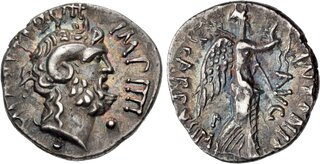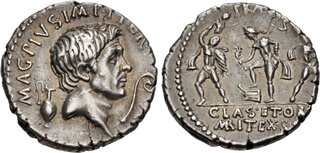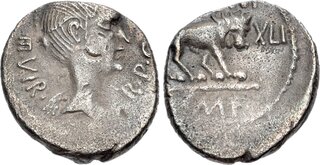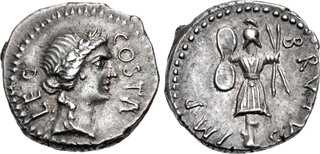Match 1:
Match 2:
Match 3:
| Classical Numismatic Group > Auction 126 | Auction date: 28 May 2024 |
| Lot number: 636 Price realized: This lot is for sale in an upcoming auction - Bid on this lot  | |
| Lot description: The Triumvirs. Mark Antony. Summer 31 BC. AR Denarius (18.5mm, 3.45 g, 11h). Cyrene mint; L. Pinarius Scarpus, imperator. Head of Jupiter Ammon right / Victory advancing right, holding wreath and palm frond over left shoulder. Crawford 546/2a; CRI 390; Sydenham 1280; RSC 1; RBW 1852. Iridescent tone, reverse deposits. Good VF. Ex Heritage 3071 (6 January 2019), lot 33245. The final issue struck in Antony's name before his defeat at Actium and his eventual suicide. Estimate: 750 USD |  |
Match 4:
| Classical Numismatic Group > Auction 126 | Auction date: 28 May 2024 |
| Lot number: 614 Price realized: This lot is for sale in an upcoming auction - Bid on this lot  | |
| Lot description: The Pompeians. Sextus Pompey. 37/6 BC. AR Denarius (19mm, 3.81 g, 6h). Uncertain Sicilian mint. Bare head of Pompey the Great right; capis to left, lituus to right / Neptune standing left, holding apluster and resting foot on prow between the Catanaean brothers Anapias and Amphinomus running in opposite directions, bearing their parents on their shoulders. Crawford 511/3a; CRI 334; Sydenham 1344; RSC 17 (Pompey the Great); RBW 1785. Light iridescent tone, short flan crack. Good VF. From the Wild Rose Collection, purchased from Pars Coins, March 2017. Ex Elvira Elisa Clain-Stefanelli Collection (Numismatica Ars Classica 92, Part II, 24 May 2016), lot 1936. Sextus Pompey came of age during the ascendancy of his father, Gnaeus Pompeius Magnus (Pompey the Great), as the leading general of Rome. After Pompey's defeat by Julius Caesar at Pharsalus in August of 48 BC, and his treacherous murder in Egypt later that year, Sextus joined the Pompeian resistance to Caesar in Spain. Caesar's assassination on March 15, 44 BC brought a brief revival of Senatorial control, during which Sextus relocated to Massalia in southern Gaul. In April of 43 BC, the Senate appointed him commander of the Roman fleet. Although the promotion was rescinded three months later, Sextus wasted no time in seizing Sicily and spent the next months building an impregnable power base on the island even as Rome fell under the sway of Caesar's political heirs, the Triumvirs Antony, Octavian and Lepidus. While the Triumvirs hunted down Caesar's assassins, Sextus enjoyed a rollicking life as a pirate king, using his fleet to raid far and wide. This attractive denarius belongs to his piratical period on Sicily and honors his father, Pompey the Great, on the obverse, while the reverse depicts the sea god Neptune along with the semi-legendary Catanaean twins, Anapius and Amphinomus, who rescued their parents from an eruption of Mount Aetna and became symbols of filial piety. Estimate: 1500 USD |  |
Match 5:







